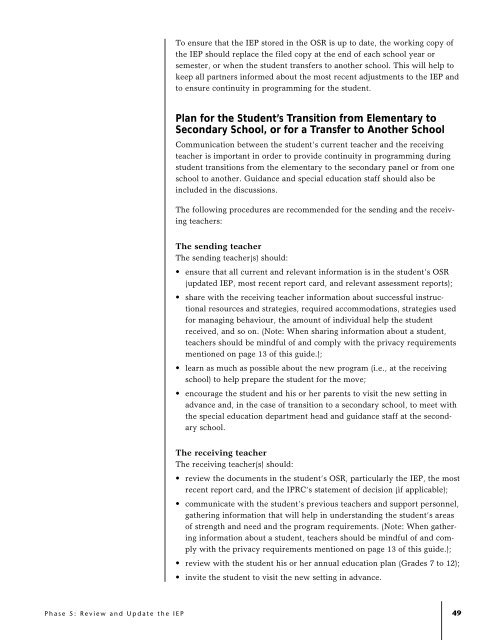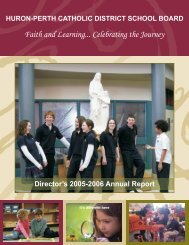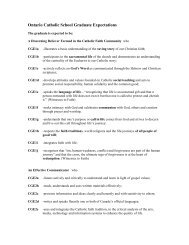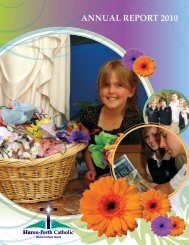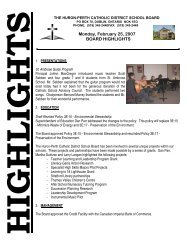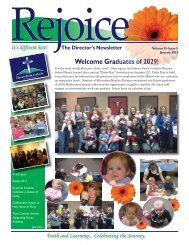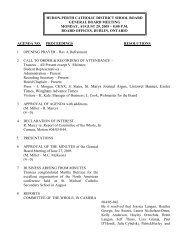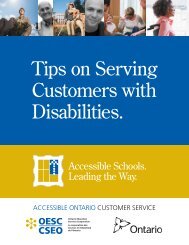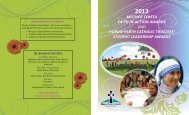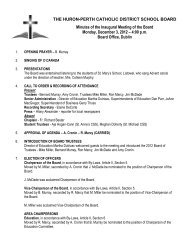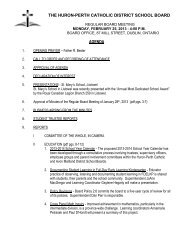The Individual Education Plan (IEP) - A Resource Guide, 2004
The Individual Education Plan (IEP) - A Resource Guide, 2004
The Individual Education Plan (IEP) - A Resource Guide, 2004
Create successful ePaper yourself
Turn your PDF publications into a flip-book with our unique Google optimized e-Paper software.
To ensure that the <strong>IEP</strong> stored in the OSR is up to date, the working copy of<br />
the <strong>IEP</strong> should replace the filed copy at the end of each school year or<br />
semester, or when the student transfers to another school. This will help to<br />
keep all partners informed about the most recent adjustments to the <strong>IEP</strong> and<br />
to ensure continuity in programming for the student.<br />
<strong>Plan</strong> for the Student’s Transition from Elementary to<br />
Secondary School, or for a Transfer to Another School<br />
Communication between the student’s current teacher and the receiving<br />
teacher is important in order to provide continuity in programming during<br />
student transitions from the elementary to the secondary panel or from one<br />
school to another. Guidance and special education staff should also be<br />
included in the discussions.<br />
<strong>The</strong> following procedures are recommended for the sending and the receiving<br />
teachers:<br />
<strong>The</strong> sending teacher<br />
<strong>The</strong> sending teacher(s) should:<br />
• ensure that all current and relevant information is in the student’s OSR<br />
(updated <strong>IEP</strong>, most recent report card, and relevant assessment reports);<br />
• share with the receiving teacher information about successful instructional<br />
resources and strategies, required accommodations, strategies used<br />
for managing behaviour, the amount of individual help the student<br />
received, and so on. (Note: When sharing information about a student,<br />
teachers should be mindful of and comply with the privacy requirements<br />
mentioned on page 13 of this guide.);<br />
• learn as much as possible about the new program (i.e., at the receiving<br />
school) to help prepare the student for the move;<br />
• encourage the student and his or her parents to visit the new setting in<br />
advance and, in the case of transition to a secondary school, to meet with<br />
the special education department head and guidance staff at the secondary<br />
school.<br />
<strong>The</strong> receiving teacher<br />
<strong>The</strong> receiving teacher(s) should:<br />
• review the documents in the student’s OSR, particularly the <strong>IEP</strong>, the most<br />
recent report card, and the IPRC’s statement of decision (if applicable);<br />
• communicate with the student’s previous teachers and support personnel,<br />
gathering information that will help in understanding the student’s areas<br />
of strength and need and the program requirements. (Note: When gathering<br />
information about a student, teachers should be mindful of and comply<br />
with the privacy requirements mentioned on page 13 of this guide.);<br />
• review with the student his or her annual education plan (Grades 7 to 12);<br />
• invite the student to visit the new setting in advance.<br />
Phase 5: Review and Update the <strong>IEP</strong><br />
49


